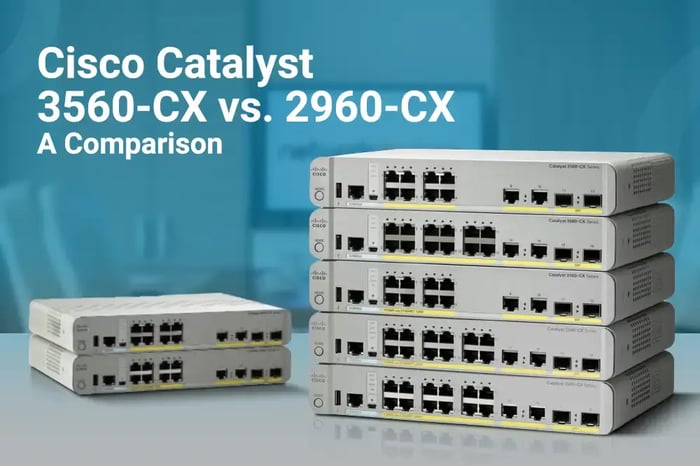You have no items in your shopping cart.

Cisco Catalyst 3560-CX vs. Catalyst 2960-CX : A Comparison
This Cisco 2960 vs. Catalyst 3560-CX guide compares two of the best series from the industry leader, Cisco. Cisco can be considered the leader in the Network industry. This position may be attributed to many reasons, such as Cisco switches being so reliable and –unlike some other vendors- performing as mentioned in datasheets and the versatile portfolio Cisco offers. The vast portfolio and the accurate datasheets ensure that customers and end users, whether Internet Service Providers (ISPs), big enterprises, or even SoHo (Small office - Home office) users, are getting what they need. In line with this perspective, Cisco is offering the 2960-CX and the 3560-CX family of switches, which are compact yet powerful switches.
In this Cisco 2960 vs. Cisco 3560 comparison, we will analyze the differences between those two series to help customers select the right switch for their application.
Cisco Catalyst 3560-CX and Cisco Catalyst 2960-CX switches are designed for scenarios where a low density of downlink ports is needed. They come with various options, such as PoE, PoE+, uplink port speeds, and feature sets. Their predecessor models, the Cisco Catalyst 3560-CG and the Cisco Catalyst 2960-CG, were already very successful. However, these two new series offer much more.
The New Features of Cisco Catalyst 3560-CX and Cisco Catalyst 2960-CX :
- Support Cisco Digital Network Architecture DNA, which allows the customer to build value on the network, so he can streamline operations and facilitate IT and business innovation.
- Enhanced uplink speed options, including 10 Gigabit Ethernet connectivity over SFP+ uplinks, allowing those switches to be used in an environment where high throughput is required.
- Multigigabit Ethernet (100-Mbps and 1-, 2.5-, 5-, and 10-Gbps) downlink/uplink ports.
- Those multigigabit downlink ports can be used to connect the new 802.11ac Wave 1 and Wave 2 Wireless Access Points APs, which require more than 1Gbps for the wired connection to work at its full power, to the network.
- This can be done without using any EtherChannel bundles to the access points, which reduces the configuration's complexity and cuts the costs of cabling, Which makes those switches ideally extend wireless LAN networks.

- Power over Ethernet PoE/PoE+ with up to 240W of PoE+, which allows those switches to power up most PoE devices, even high-end devices like the 802.11ac APs and PTZ IP cameras.
- PoE pass-through in some 3560-CX models, which can be considered the industry's first Cisco Universal PoE (Cisco UPOE)-powered switch with PoE pass-through, which enables the compact switch to draw power from the wiring closet and pass it to end devices. It also has the option to be powered by an auxiliary AC-DC or DC-DC power adapter. It offers up to 146W of PoE+, which is about six times the power budget of the previous generation.
- Network Plug and Play (PnP) for easy configuration, which automates the installation and configuration of Cisco IOS Software using an embedded PnP agent on Cisco Catalyst switches.
- An option to run in Instant Access mode, which is a solution that allows customers to dramatically simplify campus network operations through a single point of operation and management for campus access and backbone. Multiple access switches connect to the Cisco Catalyst 6500 or 6800 backbone switches, and the entire configuration works as a single extended switch with a single management domain. In this mode, the access switches inherit all the features of the Cisco Catalyst 6500 or 6800.

- Cisco IOS NetFlow Lite, a Cisco IOS Software feature that uses sampled flows to provide statistics for network traffic accounting, monitoring, and planning. A flow is created using a flow record, which defines the unique keys of the flow. NetFlow Lite provides valuable information about network users and applications, peak usage times, and traffic routing.
- Perpetual PoE allows the 2960-CX and 3560-CX switches to provide uninterrupted power to a powered-down device even when the switch is booting. A customer can connect any PoE-powered device (access point, IP phone, etc.) to the switch port and reload the switch. The PoE-powered device will continue to work and get the last negotiated power.
- Switch Hibernation Mode, in which the 2960-CX and 3560-CX switches are put to sleep when not in use. This feature enables the switches to save up to 80 percent of power during non-business hours.
- An option to upgrade to the advanced Layer 3 IP Services feature set, which includes enterprise-grade protocols like BGP, PIM, VRF, OSPF, HSRP, IPSLA, etc.

So at this point, we come to the critical question:
What is the difference between the Cisco Catalyst 2960-CX and the 3560-CX switches?

The table below shows the differences between the Cisco IOS Software feature sets on Cisco Catalyst 3560-CX and 2960-CX:

Final Thoughts
Cisco Catalyst 2960-CX switches are considered layer 2 switches, which are more suitable to be used as a layer 2 edge switch where 1G uplinks and enterprise-grade –yet not complete- feature sets are enough. On the other hand, Cisco Catalyst 3560-CX switches offer complete feature sets and 10G uplink ports.
We at Network Devices Inc. offer the entire portfolio of both Cisco Catalyst 2960-CX and 3560-CX series. If you still have questions, you can CONTACT our CCIE-Level Support Team or SHOP NOW.












